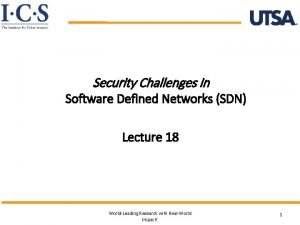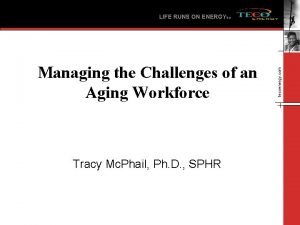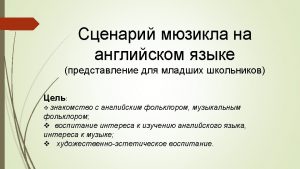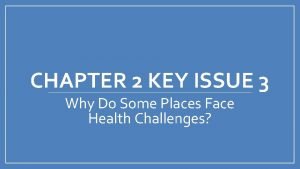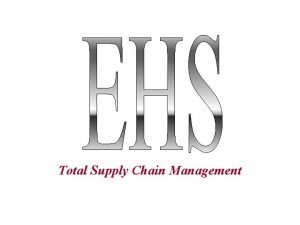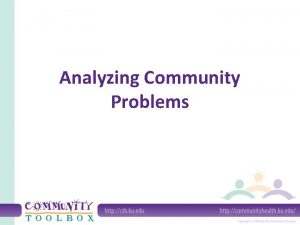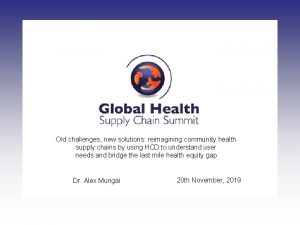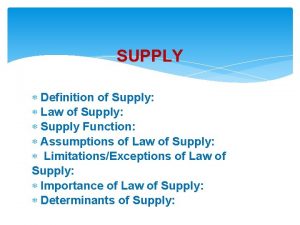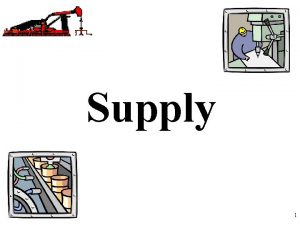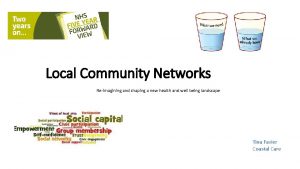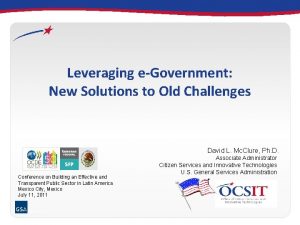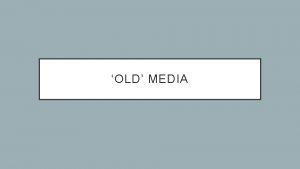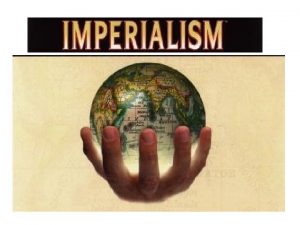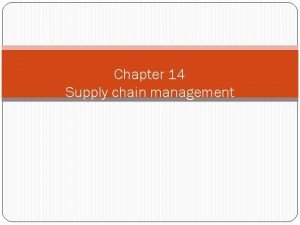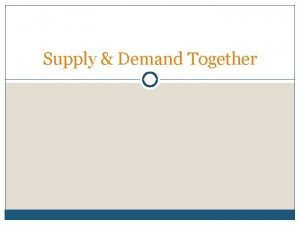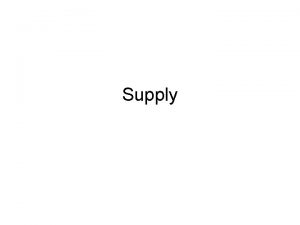Old challenges new solutions reimagining community health supply





















- Slides: 21

Old challenges, new solutions: reimagining community health supply chains by using HCD to understand user needs and bridge the last mile health equity gap Dr. Alex Mungai 20 th November, 2019

Thanks to our generous sponsors

Old challenges, New solutions: Re-imagining community health supply chains using HCD to understand user needs and bridge the last mile health equity gap Dr. Alex Mungai Samburu County Pharmacist 2019 Global Health Supply Chain Summit, Johannesburg, S. Africa

Adapting c. Stock for nomadic communities c. Stock is a supply chain strengthening approach for community health programs that: • Uses mobile technology for demand-based resupply procedures • Connects CHVs to their resupply facilities • Includes user-friendly dashboards for better visibility, accountability and transparency • Fosters data use and local problem solving using IMPACT teams p. 4

HCD Intent Statements • How we can better strengthen health supply chains to migratory, hard-to-reach communities through the adaptation of c. Stock and a community health model? • How will women of a reproductive age (our end beneficiaries) perceive themselves, perceive health, perceive their own influences and motivations around health and health seeking behaviours, and what are their health services needs? • Can we better understand their trust circles and spheres of influence, especially by family groups, their community as well as broader cultural and societal beliefs, norms and rituals in their community and region.

Human Centered Design Approach February March-May June - present Ongoing CON VER GE E G IVER D Ideation Prototyping Establish Intent Research Design and Practice Redesigned and tested tools Testing Problem Identification Insight Generation Refine or Pivot Iteration Understand intent Research and surface insights Ideas and prototypes Formulate and evaluate Human Centered Design is a methodology that puts the creation of solutions for user challenges back in the user’s hands

Human Centered Design Approach Interviews, Observations & 1 Usability Tests 2 Samburu Central and East (35 participants) Wajir Central and West (27) 3 Insights distilled into categories for ideation and prototyping “Illiteracy for CHV is a big challenge. Only 10 CHVs (in my unit) know how to read and write. 5 CHVs have to be assisted. ” -CHA, Samburu 4 Developed 8 Personas: • WRA (2) • Community Leader (1) • Husband (1) • CHV (3) • Nurse (1) Four prototypes to further iterate and develop Redesigned Manual Tools CHA portal User friendly c. Stock app USSD/SMS Hybrid Reporting p. 7

“Balancing between my personal work and CHV work is not easy. We were promised a monthly stipend but we have never received it. This is demoralising. ” About me The 8 personas were used during ideation & prototyping to include their voices as part of design I have been a CHV for several years now. I am married with 6 kids. I feel Lolopul good when the community seek Fenale CHV, advice from me. I visit households to educate them on handwashing, Samburu County nutrition and family planning. I also mobilize the community during Each Persona has the outreaches. Sometimes my personal following sections: and family activities are affected by • About Me community work. I don’t get paid • My motivation and therefore I am unable to take • My challenges care of my family they way I would • My thoughts on FP want. I sometimes help the CHA • My thoughts on health when he is busy by collecting • When designing for me reports from the other CHVs. I love my job because it increases my remember that status in the society, people listen to me. When designing for me, remember that: 1 I feel demotivated since the promised stipend has never come. I worry about how I am to take care of my family 2 I feel good when the community seeks health services from me, I only handle condoms 3 I don’t recommend women get FP without a husband’s consent and I help husbands to draft consent notes for their wives to get FP at the facility

A day in the life of a female CHV: a woman and a volunteer My health facility and CHV rounds 5 am Done for the day I usually go to the hospital at 10 am and assist with tasks like weighing babies, helping with deliveries and cleaning the facility. I am not trained for this but I try and do what I can. I leave the facility at around 1 pm and go to the community to conduct household visits to promote health education and give referrals. I have to dress appropriately during meet ups for example when meeting men I cannot wear trousers, they would not give me the respect I deserve as a CHV. It is hard work as I walk long distances and get exhausted. It sometimes gets demotivating as most men do not allow their wives to use family planning. But Women get FP without the knowledge of their husbands most of the time. I love being a CHV because of the impact I see in the community. There are times I get frustrated because I am not paid any stipend. Morning chores and routine When I wake up I start to prepare breakfast for the family. When they have eaten, I prepare the children for school. I also start to prepare food for the children for when they come back from school and for my son who goes to take care of animals. I milk goats and take the small goats to get food. I then walk to the water point to fetch water. I wait in line a long time, there is always a a queue. 10 am At the end of the month, we have monthly CHV meetings, the clinicians, CHAs, CHVs and sometimes Afya Timiza attend these meetings. We give a account of the work we have done and submit the reports; MOH 100 and MOH 514. Some people come late because they come from very far, but they travel to report. Not all the time, because some of us live very far and during the day it can also get very hot. 3 pm I got to bed if I am lucky at 10 pm. I think about all I have to do the next day and I know that it will be a full day again. Men, especially male CHVs don’t do as much as we do but as women in our communities, we are used to doing a lot of the chores in a household, including dealing with livestock. It’s just how it is. Tomorrow is another day. My afternoon chores I usually go home around 3 pm and count the goats that have been brought back. The children bring back the goats, I count and they take to them their sheds. I then prepare food for the family and eat at around 8 pm. I do all my chores like washing clothes and doing the dishes. There is no time for a woman to rest, especially if you are a CHV like me. 10 pm

20 Categories of Insights CHVs trusted for information, not medical services or handling of commodities ““I am skeptical of doing it myself. The CHV? She is not a nurse. I trust the doctor more. ”- WRA, Samburu “I don’t think the community will accept CHVs to offer FP services because this most of them are illiterate and this is a medicine” CHA, Wajir “CHVs do not give any commodities. What they do is refer patients to the health facilities. ’ Facility in charge, Samburu There are clinics that are targeted to nomadic, semi-nomadic populations but they are not all operational or used to their full potential “The facilities are far apart. The facilities are not enough and they aren’t really helping in terms of nomadic populations. ”- Sub County Health Management Team, Wajir “The nomadic clinics go to static settlements where there are no dispensaries. If they were designed differently, they would reach the nomads. ” Sub County Health Management Team, Wajir “We have several nomadic clinics, we have given them MFL geocodes, so that they can receive supplies as well. ”- County Health Management Team, Wajir 2019 Global Health Supply Chain Summit, Johannesburg, S. Africa

Usability Insights in Detail c. Stock app’s General and Login challenges • The network is not always available or reliable • The navigation is too many steps and too complicated for users • Electricity means phones can’t always be charged c. Stock app’s Terminology and language • The language and terminology is too complex. Which needs to be simplified. • Finding a universal language to use for the app was difficult. Not all users know English and Swahili as well as their local language to effectively navigate the app. c. Stock app Enhance visual cues • The space to key in data based on the commodity was not clear and intuitive. • Users did not know when they had submitted the report, this needs to be clear and intuitive • Saving was counter intuitive to the users. It required the user to go back to the top of the page. SMS General • SMS was hard for people to use in general, some found it easier than others • There was no clear feedback to users on successful submission of reports. 2019 Global Health Supply Chain Summit, Johannesburg, S. Africa

Ideation & Prototyping Workshop Redesigned Manual Tool Designing a CHA portal User Friendly c. Stock app USSD/SMS Hybrid Reporting 2019 Global Health Supply Chain Summit, Johannesburg, S. Africa

c. Stock: What Informed our Models? Using our personas and insights, we created two models based on differing skills, motivations and contexts within the health system in Northern Kenya. Our guiding principles: 1. Models that could be applied to all counties, and have variations for different skill levels; 2. Redesigned, more intuitive manual records for each data flow; 3. CHAs to mentor CHVs along the pathway of use to accommodate low literacy 4. We want to test and use the most intuitive medium. 2019 Global Health Supply Chain Summit, Johannesburg, S. Africa

Model One: CHA enters or validates data for low tech capacity CHVs In this model, the assumption is that the CHA is better at these things and will be only entering data on behalf of the CHVs who cannot do it until they learn how to, after which point the CHA just performs a data validation function. The other high tech capacity CHVs, will continue to enter the data directly into a tech solution. 3. CHVs send the manual tool data to CHA 1. CHA identifies CHVs who need assistance. 2. All CHVs record data on an easy to use virtual manual tool. 6. Eventually, CHVs familiarized with the process can enter data. 4. CHA enters the data into the tech solution. 5. Some CHVs overtime will be able to manually enter data into the tech solutions, after validation from CHA. 2019 Global Health Supply Chain Summit, Johannesburg, S. Africa

Model Two: High tech capacity CHVs enter in their own data In this model, the assumption is that the CHVs that have high tech capacity will enter the data to a manual tool, that will be delivered to the CHA. However in the meantime, these CHVs will enter data directly via a tech solution straight from the community level. There will be no entering or validation of this data by the CHA on their behalf. 3. The manual tool data is sent to the CHA via a medium that is readily convenient to the CHVs. 1. CHA hand picks CHVs that show high technical competency. 2. The CHVs are then taken through recording data into the visual manual tool. 4. In the meantime, all of the CHVs with high tech capacity are entering in their own data (via app, SMS or USSD) 2019 Global Health Supply Chain Summit, Johannesburg, S. Africa

User Friendly c. Stock App for CHV use : The Iteration The prototype that was refined based on user testing feedback

Draft Product & Data Flow, Accommodating Migration Patterns 2019 Global Health Supply Chain Summit, Johannesburg, S. Africa

Lessons and Conclusions • HCD requires intention and collaboration from national, sub-national and partners to kick start support for ‘design consumers’ and trigger critical decisions needed for buy-in and sustainability of system redesign • Prototype testing for products is fairly linear compared to that for systems, which are interconnected and include problems out of our ability to influence • Insights generated from interacting with a variety of community members beyond HCWs were incredibly valuable in identifying barriers to health seeking from CHVs and illuminate how to design around some of these challenges. – Example: CHVs are trusted as information and advice providers and not as commodity issuers or handlers and the defined CHV kit isn’t well adopted; thinking through the CBD strategy must be informed by these insights 2019 Global Health Supply Chain Summit, Johannesburg, S. Africa

Next Steps • Implement the redesigned models of the c. Stock along side other supply chain, service delivery and demand generation approaches • Evaluate the models using Developmental Evaluation (DE): – DE is an evaluation approach that aims to iterate on implementation models in real-time by fostering a deeper understanding of the vast amount of information emerging – We are using DE to document barriers and facilitators to implementation as well as evaluate the model’s effects on community health service uptake 2019 Global Health Supply Chain Summit, Johannesburg, S. Africa

THANK YOU • MOH Kenya • Samburu, Turkana, Wajir Counties • in. Supply Health • Sarah Hassanen www. insupplyhealth. c in. Supply regularly publishes and disseminates findings. om Email insupply@jsi. com if you would like to receive our newsletter and other communications. insupply@jsi. com

Thanks to our generous sponsors 2019 Global Health Supply Chain Summit, Johannesburg, S. Africa
 Reexamining the examen
Reexamining the examen New-old approach to creating new ventures
New-old approach to creating new ventures Njbta
Njbta Role and responsibility of occupational health nurse
Role and responsibility of occupational health nurse Global supply chain management challenges
Global supply chain management challenges Global supply chain management challenges
Global supply chain management challenges Oil and gas supply chain challenges
Oil and gas supply chain challenges Sdn security challenges and solutions
Sdn security challenges and solutions Managing the aging workforce challenges and solutions
Managing the aging workforce challenges and solutions And how old are you
And how old are you Once upon a time a little man running
Once upon a time a little man running Once upon a time there lived an old man and an old woman
Once upon a time there lived an old man and an old woman Once upon a time there lived an old woman
Once upon a time there lived an old woman The new nation faces challenges
The new nation faces challenges Chapter 2 population and health key issue 3
Chapter 2 population and health key issue 3 Chapter 5 section 1 supply and the law of supply
Chapter 5 section 1 supply and the law of supply Pagbabago sa dami ng supply at pagbabago sa supply
Pagbabago sa dami ng supply at pagbabago sa supply Matching supply with demand
Matching supply with demand Total supply chain solutions
Total supply chain solutions Problem solution expository essay
Problem solution expository essay Community examples
Community examples What is the difference between the old and new covenant
What is the difference between the old and new covenant







